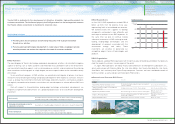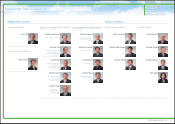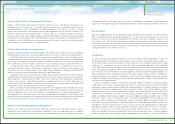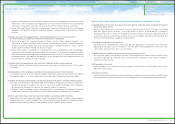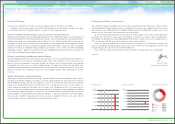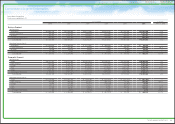Toyota 2011 Annual Report Download - page 36
Download and view the complete annual report
Please find page 36 of the 2011 Toyota annual report below. You can navigate through the pages in the report by either clicking on the pages listed below, or by using the keyword search tool below to find specific information within the annual report.
Management and
Corporate Information
Business and
Performance Review
Financial Section and
Investor InformationSpecial Feature
Message/Vision
Risk Factors
assurance that Toyota will be capable of developing and manufacturing new, price competitive products in
a timely manner with its available technology, intellectual property, sources of raw materials and parts and
components, and production capacity, including cost reduction capacity. Further, there is no assurance that
Toyota will be able to implement capital expenditures at the level and times planned by management.
Toyota’s inability to develop and offer products that meet customers’ preferences and demand with respect
to quality, safety, reliability, styling and other features in a timely manner could result in a lower market share
and reduced sales volumes and margins, and may adversely affect Toyota’s financial condition and results
of operations.
Toyota’s ability to market and distribute effectively is an integral part of Toyota’s successful sales.
Toyota’s success in the sale of vehicles depends on its ability to market and distribute effectively based on
distribution networks and sales techniques tailored to the needs of its customers. There is no assurance that
Toyota will be able to develop sales techniques and distribution networks that effectively adapt to changing
customer preferences or changes in the regulatory environment in the major markets in which it operates.
Toyota’s inability to maintain well-developed sales techniques and distribution networks may result in
decreased sales and market share and may adversely affect its financial condition and results of operations.
Toyota’s success is significantly impacted by its ability to maintain and develop its brand image.
In the highly competitive automotive industry, it is critical to maintain and develop a brand image. In order to
maintain and develop a brand image, it is necessary to further increase customers’ confidence by providing
safe, high-quality products that meet customer preferences and demand. If Toyota is unable to effectively
maintain and develop its brand image as a result of its inability to provide safe, high-quality products or as
result of the failure to promptly implement safety measures such as recalls when necessary, vehicle unit
sales and/or sale prices may decrease, and as a result revenues and profits may not increase as expected
or may decrease, adversely affecting its financial condition and results of operations.
Toyota relies on suppliers for the provision of certain supplies including parts,
components and raw materials.
Toyota purchases supplies including parts, components and raw materials from a number of external
suppliers located around the world. For some supplies, Toyota relies on a single supplier or a limited number
of suppliers, whose replacement with another supplier may be difficult. Inability to obtain supplies from a
single or limited source supplier may result in difficulty obtaining supplies and may restrict Toyota’s ability to
produce vehicles. Furthermore, even if Toyota were to rely on a large number of suppliers, first-tier suppliers
with whom Toyota directly transacts may in turn rely on a single second-tier supplier or limited second-tier
suppliers. Toyota’s ability to continue to obtain supplies from its suppliers in a timely and cost-effective
manner is subject to a number of factors, some of which are not within Toyota’s control. These factors
include the ability of Toyota’s suppliers to provide a continued source of supply, and Toyota’s ability to
effectively compete and obtain competitive prices from suppliers. A loss of any single or limited source
supplier or inability to obtain supplies from suppliers in a timely and cost-effective manner could lead to
increased costs or delays or suspensions in Toyota’s production and deliveries, which could have an adverse
effect on Toyota’s financial conditions and results of operations.
The worldwide financial services industry is highly competitive.
The worldwide financial services industry is highly competitive. Increased competition in automobile
financing may lead to decreased margins. A decline in Toyota’s vehicle unit sales, an increase in residual
value risk due to lower used vehicle price, an increase in the ratio of credit losses and increased funding
costs are factors which may impact Toyota’s financial services operations. If Toyota is unable to adequately
respond to the changes and competition in automobile financing, Toyota’s financial services operations may
adversely affect its financial condition and results of operations.
Financial Market and Economic Risks
Toyota’s operations are subject to currency and interest rate fluctuations.
Toyota is sensitive to fluctuations in foreign currency exchange rates and is principally exposed to fluctuations
in the value of the Japanese yen, the U.S. dollar and the euro and, to a lesser extent, the Australian dollar,
the Canadian dollar and the British pound. Toyota’s consolidated financial statements, which are presented
in Japanese yen, are affected by foreign currency exchange fluctuations through both translation risk and
transaction risk. Changes in foreign currency exchange rates may affect Toyota’s pricing of products sold
and materials purchased in foreign currencies. In particular, strengthening of the Japanese yen against the
U.S. dollar can have an adverse effect on Toyota’s operating results. The Japanese yen has been appreciating
against major currencies including the U.S. dollar in the past year. If the Japanese yen continues to appreciate
against major currencies, including the U.S. dollar, Toyota’s financial condition and results of operations may
be adversely affected.
Toyota believes that its use of certain derivative financial instruments including interest rate swaps and
increased localized production of its products have reduced, but not eliminated, the effects of interest rate
and foreign currency exchange rate fluctuations. Nonetheless, a negative impact resulting from fluctuations
in foreign currency exchange rates and changes in interest rates may adversely affect Toyota’s financial
condition and results of operations.
High prices of raw materials and strong pressure on Toyota’s suppliers could negatively impact
Toyota’s profitability.
Increases in prices for raw materials that Toyota and Toyota’s suppliers use in manufacturing their products
or parts and components such as steel, precious metals, non-ferrous alloys including aluminum, and plastic
parts, may lead to higher production costs for parts and components. This could, in turn, negatively impact
Toyota’s future profitability because Toyota may not be able to pass all those costs on to its customers or
require its suppliers to absorb such costs.
The downturn in the financial markets could adversely affect Toyota’s ability to raise capital.
Should the world economy suddenly deteriorate, a number of financial institutions and investors will face
difficulties in providing capital to the financial markets at levels corresponding to their own financial capacity,
and, as a result, there is a risk that companies may not be able to raise capital under terms that they would
expect to receive with their creditworthiness. If Toyota is unable to raise the necessary capital under
appropriate conditions on a timely basis, Toyota’s financial condition and results of operations may be
adversely affected.
0725
R&D and Intellectual Property
Corporate Philosophy
Management Team
Corporate Governance
Risk Factors
Other Management and Corporate Data
36TOYOTA ANNUAL REPORT 2011



